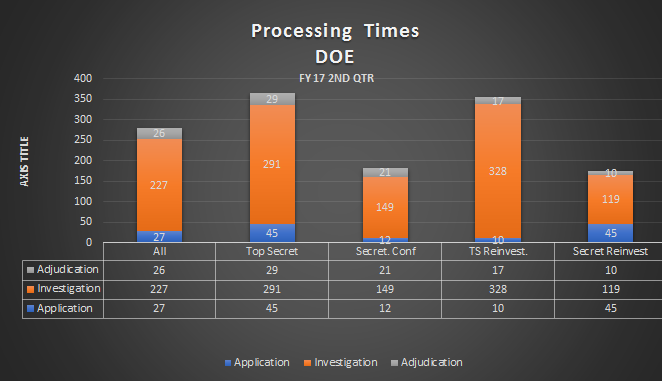The Department of Energy (DoE) is one of a few agencies that runs its own personnel security clearance program. That doesn’t mean it has avoided the problem with delays. The Office of Personnel Management processing the majority of DoE’s security clearances. Here’s a look at the time it takes to process security clearances and the effect the delay has on DoE and its related industries/contractors.
The chart below shows the processing times for the DoE’s Fiscal Year (FY) 2017 2nd quarter by security clearance level for the three steps: application, investigation and adjudication, along with reinvestigations.

Data courtesy of National Background Investigations Bureau
The numbers
Its numbers are as staggering as the DoD’s. Because the DoE has the same goal of 114 days for Top Secret clearances, the breakdown is the same:
- 14 days for the application
- 80 days for investigation
- 20 days for adjudication
… but the processing time as of March 2017 for the fastest 90% of initial Top Secret applications was still too high when compared to the goal at 365 days; Secret/Confidential had a goal of 74 days, while their actual processing took 182 days.
As far as number of adjudications processed during FY 2017 2nd quarter, the numbers are:
- 1,638 – Initial
- 923 – Top Secret
- 715 – Secret/Confidential
- 1,775 – Top Secret Reinvestigations
- 1,131 – Secret Reinvestigations
Reinvestigations
Looking at the chart data, the trend here is similar to the DoDs meaning reinvestigations at this agency overall take almost as long as the initials for the same level of clearance; it is the number of days at each stage that differ.
With the DoE having its own personnel security program that processes and issues clearances, you would think their system would be faster, but because background investigations for their employees, and any civilian, military and contract employees falling under them, must go through OPM, their requests end up in the funnel with of all the other agencies’ requests going to OPM.
This funnel effect holds up the rest of the clearance process at the DoE until the investigation comes back from OPM. Unless OPM’s manpower and budget is increased dramatically, or the background investigation process decentralized to more agencies, OPM can only process so many applications per day with the manpower and budget they have available.
And the lack of manpower is not the only fly in the ointment. Vacations, sick leave, family leave, etc. are all legitimate reasons for a federal employee to be away from work. In the end, time away from work impacts the number of investigations processed in a given year. And this carries over to the DoE doing their part both before and after the background investigation.
The Effect of doe clearance delays
At the DoE, and the agencies/industries under its umbrella, personnel not having access to classified information could miss information about an upcoming or imminent cybersecurity threat that could have the potential to shut down whole energy delivery systems, such as gas or electric grids.
In December 2016, the Obama administration released an action plan on the electric grid, calling on the DoE to “convene a discussion” about how to ensure industry personnel have security clearances within 120 days of the report’s Dec. 6 release.
As the chart shows, even a Secret clearance is still taking 182 days as of the end of 2nd quarter FY17; 365 days for a Top Secret. And then there is the issue of OPM having to do the background investigations, which is a part of the process out of DoE’s control. Under current clearance processing guidelines, the 120 day goal will never be achieved.




